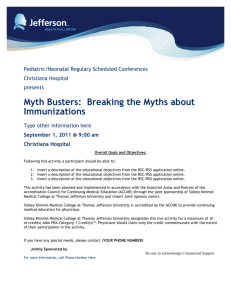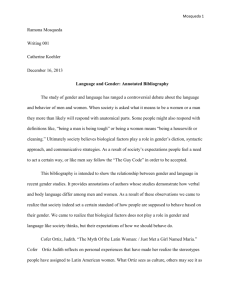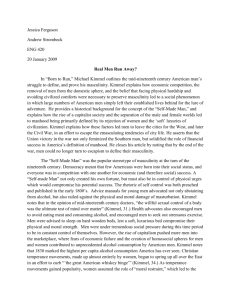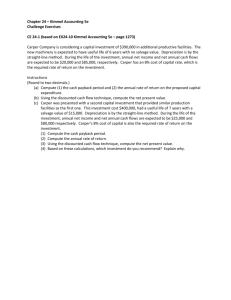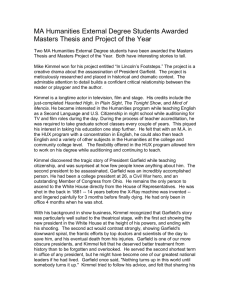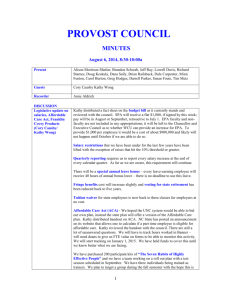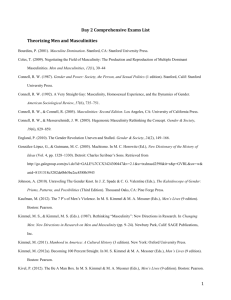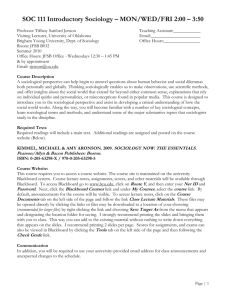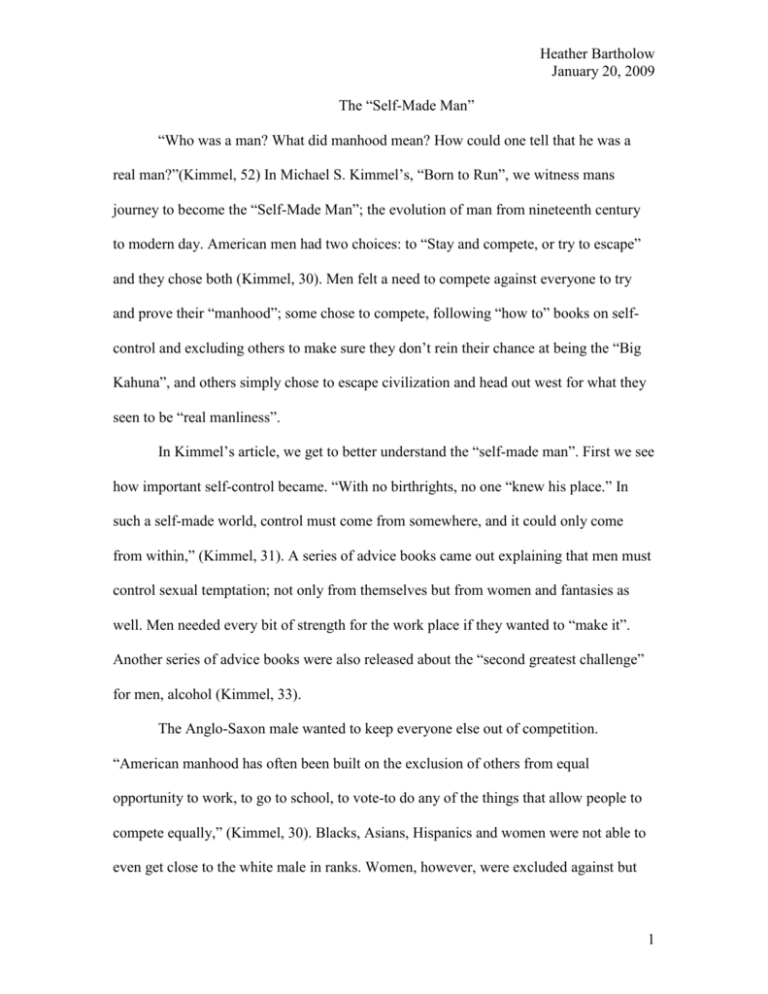
Heather Bartholow
January 20, 2009
The “Self-Made Man”
“Who was a man? What did manhood mean? How could one tell that he was a
real man?”(Kimmel, 52) In Michael S. Kimmel’s, “Born to Run”, we witness mans
journey to become the “Self-Made Man”; the evolution of man from nineteenth century
to modern day. American men had two choices: to “Stay and compete, or try to escape”
and they chose both (Kimmel, 30). Men felt a need to compete against everyone to try
and prove their “manhood”; some chose to compete, following “how to” books on selfcontrol and excluding others to make sure they don’t rein their chance at being the “Big
Kahuna”, and others simply chose to escape civilization and head out west for what they
seen to be “real manliness”.
In Kimmel’s article, we get to better understand the “self-made man”. First we see
how important self-control became. “With no birthrights, no one “knew his place.” In
such a self-made world, control must come from somewhere, and it could only come
from within,” (Kimmel, 31). A series of advice books came out explaining that men must
control sexual temptation; not only from themselves but from women and fantasies as
well. Men needed every bit of strength for the work place if they wanted to “make it”.
Another series of advice books were also released about the “second greatest challenge”
for men, alcohol (Kimmel, 33).
The Anglo-Saxon male wanted to keep everyone else out of competition.
“American manhood has often been built on the exclusion of others from equal
opportunity to work, to go to school, to vote-to do any of the things that allow people to
compete equally,” (Kimmel, 30). Blacks, Asians, Hispanics and women were not able to
even get close to the white male in ranks. Women, however, were excluded against but
1
Heather Bartholow
January 20, 2009
also depended upon at the same time. Men needed women. “It was a woman’s job to act
as moral restraint, since men, alone, were not capable of restraining their baser emotions,
their violence, their aggressive, competitive, acquisitive edge,” (Kimmel, 37).
Around the 1830’s Horace Greeley told men, “Go West, young men, and grow up
with the country,” (Kimmel, 41). That started the “westward rush” and many men left
civilization to go prove their manhood out in the rugged land where you had to perform
strenuous work and be a “mans-man”. (Kimmel, 41) This “masculine escape” confused
many men and “American men were uncertain which model of masculinity would
emerge triumphant in the second half of the century,” (Kimmel, 46-47). Which brings us
back to the question, “Who was a man?” (Kimmel, 52)
The balance of women in the man’s life is an interesting push, pull factor. Women
were told to stay at home and take care of the house but at the same time men needed
women to stabilize themselves; to help them escape from the cut throat world. Men were
content with women in the home and when women tried to educate themselves, they were
told, “Education “would only confuse these feebleminded creatures…” (Kimmel, 39)
“Women had become prisoners in the home, then men were increasingly exiled from the
home, unable to return without fear of feminization,” (Kimmel, 39). At the same time that
men were trying to exclude women from the world, women acted as “moralizers,” who
would elicit moral behavior from men,” (Kimmel, 38). It is a never ending relationship in
which men need women but don’t want them to have any chance of “beating” him in his
race for first place.
The “Self-Made Man” is another interesting critical term in which there is not one
clear answer. Kimmel describes the “self-made man” as, “If social order, permanence,
2
Heather Bartholow
January 20, 2009
could no longer be taken for granted and a man could rise as high as he aspired, then his
sense of himself as a man was in constant need of demonstration. Everything became a
test-his relationship to work, to women, to nature and to other men,” (Kimmel, 30). The
“self-made man” had to always be ready for the next young “hot shot” to rise and
compete for his place as a man. The “self-made man” needed to prove himself to
everyone and failing just was not an option.
The evolution from nineteenth century man to modern day man is extraordinary.
“How to” books emerged as top sellers due to the rise in the “self-made man”. Between
1790 and 1830 the “great American whiskey binge” occurred and “men’s drinking habits
“grew out of the anxiety of their condition.””(Kimmel, 34) When women started to
educate themselves, they grew independent and became a threat to men in the work place.
And during the civil war, white males had to prove their manhood against African
Americans as well with the abolishment of slavery. After the war “American men still
struggled to carve out a world in which they could successfully experience their
manhood,” (Kimmel, 53).
In Kimmel’s, “Born to Run”, Graham laid out his do’s and don’ts of self-control
on page 32 and 33. “Graham warned that socializing boys to bad habits of “luxury,
indolence, voluptuousness and sensuality” would lead them to surrender their “nobleness,
dignity, honor, and manhood” and reenact the fall from grace into a debased near devilry,
becoming: … a ruined soul,” (Kimmel, 32). Graham’s ideas were along the lines of the
things we discussed in The Virginian about the east and how they become lazy after
having luxuries. Graham states that men need to avoid temptations of sexual means. As
3
Heather Bartholow
January 20, 2009
well as with women; he thinks you should only be sexual with a woman once a month
and all day-dreams “must be suppressed,” (Kimmel, 33).
As men were excluding women, “motherhood was advancing, fatherhood was in
retreat,” (Kimmel, 39). Sarah Pierce’s statements, in Kimmel’s article on page 39, stated
showed how exclusion was a bad thing and that, “Most men are so entirely engrossed by
business as to have but little opportunity of fully understanding the characters of their
children” and “the term father no longer had unequivocally positive connotations,”
(Kimmel, 39). Pierce shows how due to men excluding themselves from others, they
really hurt their children and family.
On page 42 of Kimmel’s article, Henry David Thoreau states that, “we need the
tonic of the wilderness.” Thoreau thought men needed liberation. Men needed to get
away even if it was in, “one’s own backyard” the same way Thoreau did. He suggests
that middle-class men need to venture into the west, (Kimmel 43). Thoreau showed that
escaping was not a bad thing or a feminized option. That actually escaping was the manly
way. That getting out west was proving your “manhood” more than surcoming to the 9 to
5. Thoreau suggests that “Ingesting the wilderness, allows middle-class men to free
themselves,” (Kimmel, 43).
How do you know which model of masculinity will truly prove your manhood;
restraining “anything which brings weariness and exhaustion” through self-control,
excluding those who are just as equal as you to “more reliably prove manhood” or
escaping to the west to live the savage life, to be free and really be a “man”. The “selfmade man” truly is a revolution from the nineteenth century to a modern day man.
4
Heather Bartholow
January 20, 2009
Works Cited
Kimmel, Michael S. Manhood in America, “Born to Run”. New York:
Oxford University Press, 2006.
Heather,
Overall, you do a good job with presenting Kimmel’s ideas, demonstrating the big choice
at the core of his article—stay and compete or run—as well as the essential irresolvability
of this choice and its affect on women and minorities. I really like that you tie Graham’s
ideas to The Virginian; obviously, the whole point of reading these articles is to apply
their ideas to the literature. I do think that some of the sections here could be expanded,
and others could be condensed. The alcohol idea gets only a short sentence, so that’s a
place to expand; in contrast, the idea of exclusion is covered in several places, and so
could be condensed. The last section of the paper is harder to follow than the first section;
here, it feels like you’re just listing random ideas from Kimmel’s article, as opposed to
presenting these ideas in an order that your readers will understand. Also, check MLA
formatting—no comma between author’s last name and page number. Finally, I think you
could do with a few less quotations here. While it’s great to engage with the text, at
times, your readers would be better served with your paraphrase of Kimmel’s ideas. Still,
this is solid in the sense of covering Kimmel’s key points. B~Andrew
5

